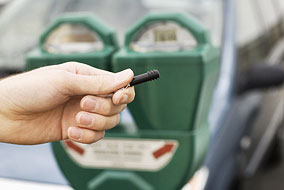
The tiny RFID tag could mark the end of carrying parking change - photo by Martin Dee UBC Reports | Vol. 52 | No. 3 | Mar. 2, 2006
Students “Un” Plug Parking Meters
Invention would do away with coins
By Brian Lin
A fellow student’s misery has inspired a team of UBC Electrical and Computer Engineering students to invent a parking meter that could make carrying change a thing of the past.
“We were brainstorming for a class project when a friend of ours walked by, all ticked off about parking on Robson Street,” says Aman Mangat, a fourth-year student who has since begun a co-op work term with Telus.
The challenge issued by the team’s instructor was simple: build something from scratch that solves a real-world problem, with a modest budget of $400.
“Right away, everybody had a parking-related horror story to offer, and it was clear that the ‘problem’ was staring us right in the face,” says Mangat.
“It always seems that when you’re in a hurry to park, you’re out of change,” says Jasim Tariq, a fourth-year student now working with Research In Motion, the Waterloo-based wireless technology company known for the Blackberry ®.
“Plus there are enormous costs associated with manual collection of the tolls that could be saved with an off-site billing system.”
The team cherry-picked existing and emerging technologies and crafted a prototype meter that is both convenient and economic, then designed the network and web-based user interface to complete the package.
Reminiscent of the Darth Vader mask, the prototype meter is wired to a magnetic sensor buried a few centimetres under the parking space.
“When a vehicle occupies the space, its bulk distorts the earth’s natural magnetic field and triggers a signal to activate the parking meter and begin the transaction,” explains third-year student Owen Kirby.
“The customer then simply waves a Radio Frequency Tag to validate his account, and the parking meter verifies it, through wireless Internet connection to the mainframe network, and initiates the transaction,” adds Gagan Deep, who worked with Kirby on the microprocessor firmware and electronic circuits of the parking meter.
To demonstrate the parking meter’s adaptability to existing technology, the team designed it to work with RF ID tag Esso® stick pass, which is a one-inch-long plastic tube that gives customers instant access to their accounts.
“We chose radio frequency identity -- or RFID -- tags like the Esso® stick because it’s widely available and costs less than 40 cents each,” says classmate Erik Schortinghuis. “The only information stored on the tag is the customer’s account number. All other pertinent information is stored on the server, protected by firewalls and other security measures.”
Shane Wang, who designed the web site and back-end software, says the site will also provide city planners valuable usage data and enable administrators to adjust rates and enforce violations in real time.
“All the billing is done centrally so it’s a breeze to administer different rates according to geographic region or time of day,” says Wang. “If a tag is stolen, for example, the customer can simply flag it through the web site and the parking meter will alert the administrator of any unauthorized use.”
“The only downside of this system,” says Mangat, “is you don’t get any free parking time. The meter stops charging as soon as the car leaves the lot.”
The team received the top marks in their course, and a recommendation to approach UBC’s University Industry Liaison Office (UILO) with their invention.
Randy Smith, Technology Transfer Manager for Physical and Computer Sciences at the UILO, says while individual components of the parking meter and billing software use existing or open source technology, the way they come together is innovative and potentially patentable.
“UBC is a North American leader in faculty research commercialization,” says Smith. “That innovative spirit seems to be rubbing off on our students.”
“We all feel inspired and excited to have taken a concept and make it a reality,” says Schortinghuis. “There is no limit to what a little imagination and determination can do.”
For more information or to test-drive the web interface, visit ipark.shanewang.com. |
